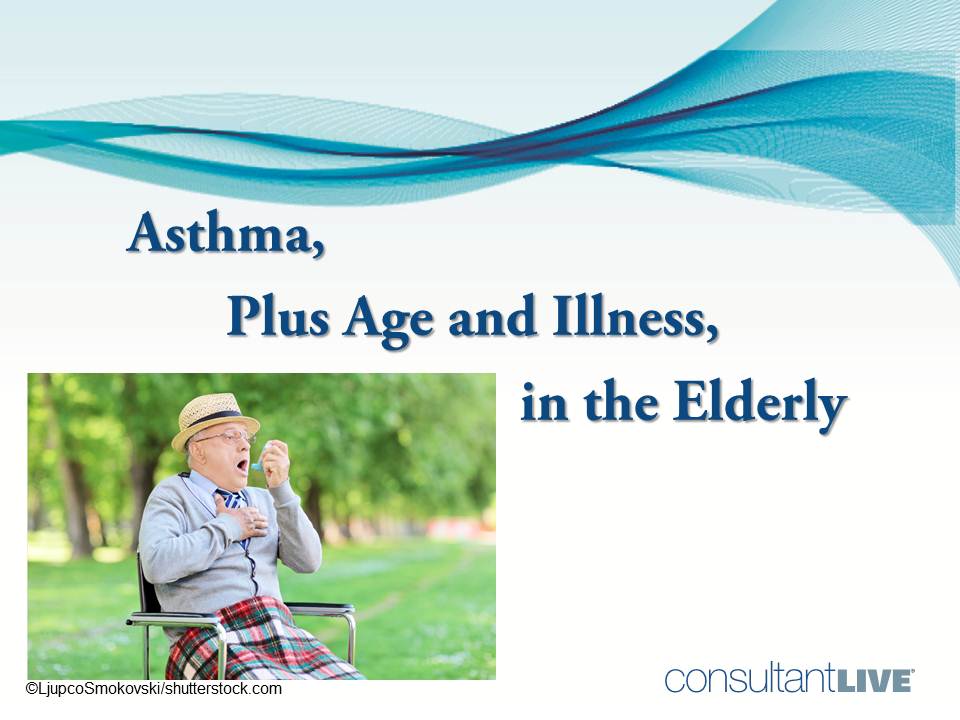Asthma in the Elderly: An Underappreciated Problem. Not rare: prevalence similar to younger individuals-from 4.5% to 12.7%(1). May overlap with or be misdiagnosed as COPD in the elderly(2). Asthma may be undertreated in ~ 34% of seniors,3 and inadequately controlled in up to 40%(4). International guidelines extrapolate research findings in younger individuals to the elderly(4). Age is often an exclusion criterion for clinical trials.
Clinical Characteristics of Asthma in the Elderly. May be a heterogeneous mix of child- and adult-onset disease. Late-onset asthma: more severe, less atopic, more small airway involvement. Declining immune function and increased proinflammatory cytokines in the elderly could play a part in elderly asthma. Age- associated decline in lung function is also important: reduced elastic recoil of the lungs and reduced chest wall compliance may increase airway hyperresponsiveness(2).
Increased comorbidities among elderly significantly associated with poor asthma outcomes(2). Polypharmacy and drug interactions: Increasing number of comorbidities increases the risk for polypharmacy, medication adherence and level of health literacy may be an issue, continuity of care and the presence of a caregiver are also important, cognitive decline may play a role. Side effects: Changes in muscle mass, fat and body water, as well as reduced activity of the kidneys and liver can change the pharmacologic effect of drugs.
Steroid concerns in the elderly: Inhaled Corticosteroids: Inhaler use may be complicated by reduced hand coordination, decreasing lung deposition and efficacy, and increasing oral deposition. Use the minimum effective dose to account for changes in systemic bioavailablity in the elderly(4). Important side effects: Possible increased risk of pneumonia, osteoporosis, fractures, worsening diabetes, HPA axis suppression. Systemic Steroids: Use at low doses for flare ups and emergencies; last resort when all other methods have failed(4) Side effects: Depression, cataracts, glaucoma, osteoporosis, adrenal insufficiency.
Short and Long-Acting Beta Agonists. Efficacy well established in elderly asthmatics(4). Can be steroid-sparing, but response may decline with age-related adrenergic dysfunction and length of use. Comorbidities increase the risk for adverse effects: Hypokalemia with poor nutrition or diuretic and insulin use, QT prolongation, tachycardia, dysrhythmias, tremor.
Anticholinergics in elderly with asthma. Short-acting anticholinergics: trials cover younger patients, so definitive conclusions about their use in the elderly are unclear. Long acting anticholinergics: well tolerated in the elderly, but Dry mouth can cause problems with speaking, mucosal damage, denture misfit; potential for mild cognitive impairment; limit long acting anticholinergics to elderly who are uncontrolled despite ICS and LABA.
Leukotriene Antagonists. Usually well-tolerated in the elderly, can be used as a first-line alternative in elderly patients with contraindications to beta2 agonists due to cardiovascular events(4). Can help decrease ICS dose or spare ICS in patients with comorbidities like osteoporosis, diabetes, glaucoma, or cataract. May improve adherence and difficulty using inhalers.
Theophyllines: High doses needed which increase side effects and limits use: GI, palpitations, arrhythmias, rare MI, seizures. Drug interactions an issue: Clearance reduced by 22-35% in the elderly, further decreased by 50% in liver disease and decreased by 50% in heart disease(4). Main use in the elderly is in severe disease as adjunctive treatment to ICS and LABA, especially in steroid resistance and in smokers(4) Careful monitoring of theophylline levels advisable in the elderly.
Additional Considerations for Asthma Management in the Elderly. Sublingual Immunotherapy (SLIT): Allergies are not considered to be a major problem in the elderly, but changes in the aging immune system may lead to increased inflammatory cytokines and IgE(2). Vaccinations: Asthma was the most common underlying condition in elderly patients hospitalized with influenza H1N1(5). Exercise: can improve aerobic capacity, breathing patterns, muscle strength, and quality of life.
Asthma is underappreciated in the elderly; may commonly go undiagnosed/misdiagnosed, leading to under treatment, poor control. Asthma in the elderly may be a mix of early- and late-onset diseases related to declining immune function and age-associated changes in lung function. Special considerations in asthma management of the elderly include the role of comorbidities, polypharmacy, drug interactions, and increased side effects. Concerns about the use of asthma medications in the elderly particularly relate to side effects, drug interactions, adherence, and cognitive issues.
The prevalence of asthma in the elderly is commensurate with that in younger individuals yet it is far more likely to be undiagnosed or misdiagnosed and so undertreated and poorly controlled.When asthma is diagnosed, management is complicated by issues unique to the aging process as well as comorbid conditions.This brief slide show is a review of what to be aware of, especially when choosing medications to manage asthma in your elderly patients.
References:
1. Yáñez A, Cho SH, Soriano JB, et al. Asthma in the elderly: what we know and what we have yet to know. World Allergy Organ J. 2014;7:8. doi: 10.1186/1939-4551-7-8. eCollection 2014.
2. Song WJ, Cho SH. Challenges in the Management of Asthma in the Elderly. Allergy Asthma Immunol Res. 2015;7:431-439. doi: 10.4168/aair.2015.7.5.431. Epub 2015 Apr 10.
3. Lee JA, L Reed P, Berg JP. Asthma characteristics among older adults: using the California health interview survey to examine asthma incidence, morbidity and ethnic differences. J Asthma. 2014;51:399-404. doi: 10.3109/02770903.2013.879879. Epub 2014 Jan 27.
4. Scichilone N, Ventura MT, Bonini M, et al. Choosing wisely: practical considerations on treatment efficacy and safety of asthma in the elderly. Clin Mol Allergy. 2015;13:7. doi: 10.1186/s12948-015-0016-x. eCollection 2015.
5. Jain S, Kamimoto L, Bramley AM, et al. Hospitalized patients with 2009 H1N1 influenza in the United States, April-June 2009. N Engl J Med. 2009 Nov 12;361(20):1935-44. doi: 10.1056/NEJMoa0906695. Epub 2009 Oct 8.















